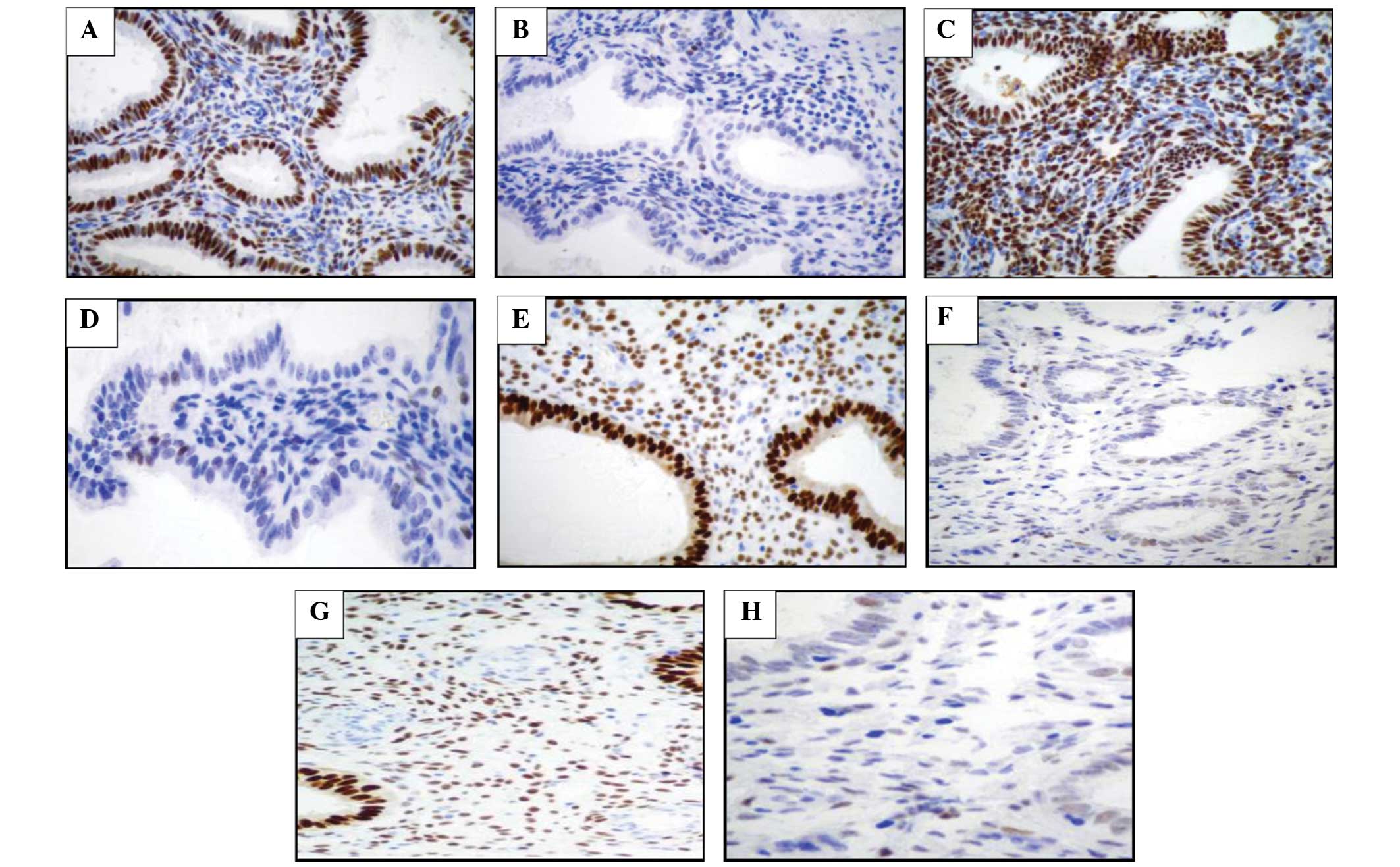|
1
|
Kurman RL: Blaustein’s Pathology of the
Female Genital Tract. 5th edition. Springer; New York: pp. 448–450.
2002
|
|
2
|
Haimov-Kochman R, Deri-Hasid R, Hamani Y
and Voss E: The natural course of endometrial polyps: Could they
vanish when left untreated? Fert Steril. 92:8282009. View Article : Google Scholar : PubMed/NCBI
|
|
3
|
Dreisler E, Stampe SS, Ibsen PH and Lose
G: Prevalence of endometrial polyps and abnormal uterine bleeding
in a Danish population aged 20–74 years. Ultrasound Obstet Gynecol.
33:102–108. 2009.
|
|
4
|
Lee SC, Kaunitz AM, Ramos LS and Rhatigan
RM: The oncogenic potential of endometrial polyps. A Systematic
Review and Meta-Analysis. Obstet Gynecol. 116:1197–1205. 2010.
View Article : Google Scholar : PubMed/NCBI
|
|
5
|
Antunes A Jr, Costa-Paiva L, Arthuso M,
Costa JV and Pinto-Neto AM: Endometrial polyps in pre- and
postmenopausal women: factors associated with malignancy.
Maturitas. 57:415–421. 2007. View Article : Google Scholar : PubMed/NCBI
|
|
6
|
Oguz S, Sargin A, KeleKei S, Aytan H,
Tapisiz OL and Mollamahmutoglu L: The role of hormone replacement
therapy in endometrial polyp formation. Maturitas. 50:231–236.
2005. View Article : Google Scholar : PubMed/NCBI
|
|
7
|
Lopes RG, Baracat EC, de Albuquerque Neto
LC, et al: Analysis of estrogen- and progesterone-receptor
expression in endometrial polyps. J Minim Invasive Gynecol.
14:300–303. 2007. View Article : Google Scholar : PubMed/NCBI
|
|
8
|
Almeida ECS, Nogueira AA, Reis FJC,
Ramalho LNZ and Zucoloto S: Immunohistochemical expression of
estrogen and progesterone receptors in endometrial polyps and
adjacent endometrium in postmenopausal women. Maturitas.
49:229–233. 2004. View Article : Google Scholar : PubMed/NCBI
|
|
9
|
Inceboz US, Nese N, Uyar Y, Ozcakir HT,
Kurtul O, Baytur YB, et al: Hormone receptor expressions and
proliferation markers in postmenopausal endometrial polyps. Gynecol
Obstet Invest. 61:24–28. 2006. View Article : Google Scholar : PubMed/NCBI
|
|
10
|
Gul A, Ugur M, Iskender C, Zulfikaroglu E
and Ozaksit G: Immunohistochemical expression of estrogen and
progesterone receptors in endometrial polyps and its relationship
to clinical parameters. Arch Gynecol Obstet. 281:479–483. 2010.
View Article : Google Scholar : PubMed/NCBI
|
|
11
|
Fons G, Hasibuan SM, van der Velden J and
ten Kate FJ: Validation of tissue microarray technology in
endometrioid cancer of the endometrium. J Clin Pathol. 60:500–503.
2007. View Article : Google Scholar : PubMed/NCBI
|
|
12
|
Harvey JM, Clark GM, Osbome CK and Allred
DC: Estrogen receptor status by immunohistochemistry is superior to
the ligand-binding assay for predicting response to adjuvant
endocrine therapy in breast cancer. J Clin Oncol. 17:1474–1481.
1999.
|
|
13
|
Costa-Paiva L, Godoy CE Jr, Antunes A Jr,
Caseiro JD, Arthuso M and Pinto-Neto AM: Risk of malignancy in
endometrial polyps in premenopausal and postmenopausal women
according to clinicopathologic characteristics. Menopause. 18:1–5.
2011. View Article : Google Scholar
|
|
14
|
Anastasiadis PG, Koutlaki NG, Skaphida PG,
Galazios GC, Tsikouras PN and Liberis VA: Endometrial polyps:
prevalence, detection, and malignant potential in women with
abnormal uterine bleeding. Eur J Gynaecol Oncol. 21:180–183.
2000.PubMed/NCBI
|
|
15
|
Martinez MA, Jou P, Nonell R, Cardona M,
Alonso I and Vanrell JA: Endometrial polyps: risk of malignancy and
clinical-anatomical correlation. Prog Obstet Ginecol. 47:506–510.
2004.
|
|
16
|
Speroff L: The estrogen receptor: changing
concepts. Clinical lessons from molecular biology. Reproductive
Medicine - A Millennium Review. Coutinho EM and Spinola P:
Parthenon Publishing Group; New York: pp. 155–161. 1999
|
|
17
|
Yen SSC: Human menstrual cycle.
Reproductive Endocrinology: Physiology, Pathophysiology, and
Clinical Management. Yen SSC, Jaffe RB and Barbieri RL: Saunders;
Philadelphia: pp. 193–227. 1999
|
|
18
|
Longcope C and Baker S: Androgen and
estrogen dynamics: relationships with age, weight and menopausal
status. J Clin Endocrinol Metabol. 76:601–604. 1993.PubMed/NCBI
|
|
19
|
McGurgan P, Taylor LJ, Duffy SR and
O’Donovan PJ: Are endometrial polyps from pre-menopausal women
similar to post-menopausal women? An immunohistochemical comparison
of endometrial polyps from pre- and post-menopausal women.
Maturitas. 54:277–284. 2006. View Article : Google Scholar : PubMed/NCBI
|
|
20
|
Pickartz H, Beckmann R, Fleige B, Due W,
Gerdes J and Stein H: Steroid receptors and proliferative activity
in non-neoplastic and neoplastic endometria. Virchows Arch A:
Pathol Anat Histopathol. 417:163–171. 1990. View Article : Google Scholar : PubMed/NCBI
|
|
21
|
Giuffre G, Arena F, Scarfi R, Simone A,
Todaro P and Tuccari G: Lactoferrin immunoexpression in endometrial
carcinomas: relationships with sex steroid hormone receptors (ER
and PR), proliferation indices (Ki-67 and AgNOR) and survival.
Oncol Rep. 16:257–263. 2006.
|
|
22
|
Moshin SK, Weiss H, Havighurst T, Clark
GM, Beraldo M, Roanhle D, et al: Progesterone receptor by
immunohistochemistry and clinical outcome in breast cancer: a
validation study. Mod Pathol. 17:1545–1554. 2004. View Article : Google Scholar : PubMed/NCBI
|
|
23
|
Ito K, Utsunomiya H, Yaegashi N and Sasano
H: Biological roles of estrogen and progesterone in human
endometrial carcinoma-new developments in potential endocrine
therapy for endometrial cancer. Endocr J. 54:667–679. 2007.
View Article : Google Scholar : PubMed/NCBI
|
|
24
|
Iversen OE, Utaaker E and Skaarland E: DNA
ploidy steroid receptors as predictors of disease course in
patients with endometrial carcinoma. Acta Obstet Gynecol Scand.
67:531–537. 1988. View Article : Google Scholar : PubMed/NCBI
|
|
25
|
Sivridis E, Giatromanolaki A, Koukourakis
M and Anastasiadis P: Endometrial carcinoma: association of steroid
hormone receptor expression with low angiogenesis and bcl-2
expression. Virchows Arch. 438:470–477. 2001. View Article : Google Scholar : PubMed/NCBI
|















